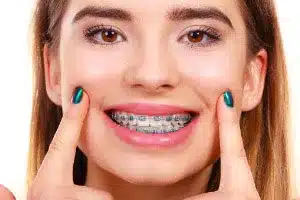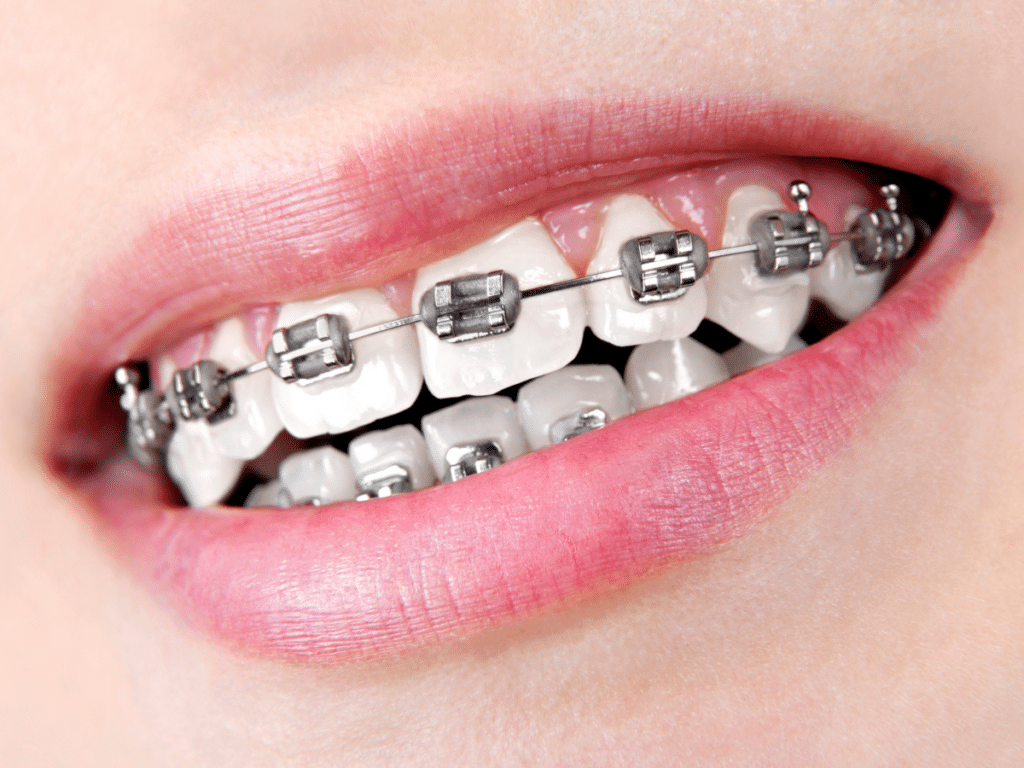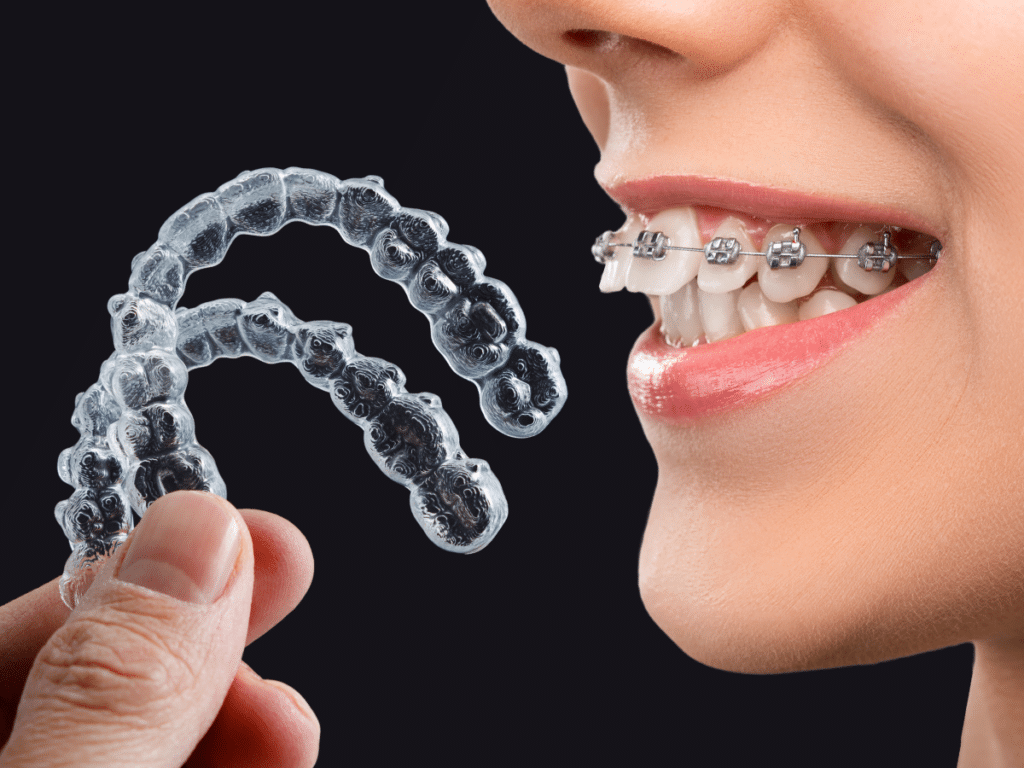Braces
- Matthews, NC
- Weddington, NC
- Stallings, NC
- Indian Trail, NC
- Wesley Chapel, NC
- Mint Hill, NC
- Waxhaw, NC
- Blakeney, NC
- Ballantyne, NC
- Fort Mill, SC
- Indian Land, SC
What are braces?

Types of Braces:
Traditional Metal Braces
Traditional metal braces are a tried-and-true method for straightening teeth for anyone located around the Charlotte, NC area. They consist of brackets that are glued to each tooth and connected by wires, which gradually shift the teeth into proper alignment over time. While they may have been in use for ages, modern orthodontics has made significant improvements to make them more comfortable and effective.
With regular adjustments from your orthodontist, you can achieve a beautiful smile in as little as 6 months. Many people choose traditional metal braces because they are affordable and can treat even the most severe cases of misalignment.

Ceramic Braces
Clear ceramic braces are the perfect solution for anyone who wants to straighten their teeth but doesn’t want the appearance of traditional metal braces. The clear, ceramic material blends in seamlessly with your teeth, making them nearly invisible while providing the necessary support to shift them into their ideal position.
Unlike other clear aligner options that can become discolored or worn over time, clear ceramic braces maintain their clarity and strength throughout the entire treatment process. If you’re looking for a discreet and reliable way to perfect your smile, ceramic braces are the way to go.

Invisalign

Hybrid Braces -- A Combination of Clear Aligners and Braces
At Quimby and Collins Orthodontics, we believe that a one-size-fits-all approach doesn’t cut it when it comes to achieving a healthy and functional smile. That’s why we also use hybrid orthodontic treatment to combine traditional braces and clear aligners for optimal results for our patients, including the residents of Charlotte and the surrounding areas currently in braces treatment at our practice.
We don’t just rely on one product or technique – we use what works best for each individual patient. By combining different types of biomechanics, we can often shorten treatment times and make the process more comfortable for our patients in the area.

What You Can Expect:
STEP 1: Complimentary Consultation
Before starting treatment, you’ll meet with one of our orthodontists, Dr. Meredith Quimby or Dr. Kelly Collins who will examine your teeth, jaw structure and soft tissue, take 3D x-rays and scans, and create a customized plan for your treatment.
During this time, you can ask any questions you may have about the treatment. It’s important to communicate any concerns or preferences with your orthodontist so they can provide you with the best care possible.
STEP 2: Placing the brackets and wires
If you choose metal, ceramic, or hybrid braces, our orthodontist will place the brackets on each of your teeth with a special adhesive. The wire will then be threaded through the brackets, and tiny elastic bands or ligatures are used to hold it in place.
While there may be some discomfort at first, this is completely normal and will subside over time.
STEP 3: Pick fun Colors
STEP 4: Discomfort or soreness
STEP 5: Changes in diet and oral hygiene routine
During your time wearing braces, it is important to be mindful of what you eat and how you care for your teeth. Hard, sticky, or chewy foods should be avoided as they can apply too much force to the braces and may cause breakage, which may delay progress.
Instead, opt for softer foods that are easier to chew. It’s also important to clean your braces properly and regularly, as they can easily trap food particles and bacteria, leading to gum disease or tooth decay.
As you can see, this is what you should expect at your initial, free consultation at Quimby and Collins Orthodontics for getting you the smile of your dreams.
Braces FAQs
How long will my braces take?
The duration of your braces treatment can vary depending on several factors:
- Complexity of Treatment: If your dental and skeletal issues are more complex, such as severe overcrowding or overbite or overjet, it might take longer to achieve the desired results.
- Age: Adults may require longer treatment times compared to children and teenagers because their jawbones are no longer growing.
- Cooperation: Following your orthodontist’s instructions, such as wearing rubber bands or appliances, keeping good oral hygiene, and attending scheduled appointments, can impact the duration of treatment.
- Type of Braces: Traditional metal braces, ceramic braces, Damon braces, and clear aligners each have different treatment times.
Typically, braces are worn for 1 to 3 years if treatment instructions are followed. Your orthodontist will provide a personalized estimate after evaluating your specific dental and skeletal situation. Regular check-ups during your treatment will also allow your orthodontist to monitor progress and make any necessary adjustments to ensure you achieve the best results in the shortest time possible.
What will my braces treatment look like?
Braces are orthodontic devices used to straighten teeth and correct bite issues. The treatment generally involves several steps:
- Consultation and Examination: Your orthodontist will conduct a thorough examination of your teeth, jaws, and overall oral health. 3D, photographs, and digital scan of your teeth may be taken to assess the severity of misalignment.
- Treatment Planning: Based on the examination, your orthodontist will create a personalized treatment plan. This plan will outline the specific dental issues that need correction and the type of braces best suited for your case.
- Placement of Braces: Once the treatment plan is established, your braces will be placed. This involves bonding brackets to the front surface of your teeth using dental adhesive. For traditional braces, metal wires are threaded through these brackets.
- Adjustments: You will need periodic appointments (usually every 4-6 weeks) with your orthodontist to adjust the braces. During these visits, the wires may be tightened, changed, or adjusted to gradually move your teeth into their correct positions.
- Monitoring Progress: Throughout the treatment period, your orthodontist will monitor the progress of your teeth movement and make necessary adjustments to the treatment plan as needed.
- Brace Removal: Once your teeth have been successfully moved into the desired positions, your braces will be removed. This process typically involves carefully detaching the brackets and removing any remaining adhesive from your teeth.
- Retention: After braces are removed, a retainer may be prescribed to prevent your teeth from shifting back to their original positions. Retainers can be removable or fixed behind your teeth. Wearing your retainers is imperative to keeping your teeth in their new position.
How painful is braces treatment?
- Initial Discomfort: When braces are first placed or after adjustments, it’s common to experience soreness and discomfort in your teeth and gums. This discomfort typically lasts for a few days as your teeth adjust to the pressure exerted by the braces.
- Mouth Sores: The brackets and wires of braces can sometimes cause irritation to the soft tissues inside your mouth, leading to sores or ulcers. Wax provided by your orthodontist can help alleviate this by providing a protective barrier.
- Tightening Discomfort: During periodic adjustments, your orthodontist may tighten the wires to continue shifting your teeth. This can temporarily increase discomfort for a day or two as your teeth start to move.
- Chewing Discomfort: You might experience discomfort while chewing, especially right after getting braces or after adjustments. This discomfort typically lessens as you get used to the braces.
- Pain Relief: Over-the-counter pain relievers such as ibuprofen or acetaminophen can help manage discomfort during the initial stages or after adjustments. Rinsing with warm saltwater can also provide relief for sore gums.
- Individual Variability: Pain tolerance varies among individuals, so some people may find braces more uncomfortable than others.
How do I take care of my braces?
- Brushing: Brush your teeth after every meal and snack, using a soft-bristled toothbrush and fluoride toothpaste. Angle your brush towards the gum line to clean around the brackets and wires thoroughly. Brush each tooth individually, including the front, back, and chewing surfaces.
- Flossing: Floss at least once a day using special orthodontic floss threaders or a floss threader tool. Thread the floss under the main wire of your braces and gently floss between your teeth and under the gums.
- Interdental Brushes: Use interdental brushes to clean between brackets and wires where regular brushing and flossing might not reach effectively.
- Rinsing: Rinse your mouth with water or mouthwash after brushing and flossing to help remove any remaining food particles and bacteria.
- Avoid Certain Foods: Avoid sticky, chewy, or hard foods that can damage your braces or get stuck in them, such as caramel, gum, hard candies, and popcorn.
- Use Wax: If your braces or wires are causing irritation to the inside of your lips or cheeks, apply orthodontic wax provided by your orthodontist to create a barrier between the braces and your mouth.
- Attend Regular Check-ups: Keep up with scheduled orthodontic appointments for adjustments and check-ups. These visits are crucial for monitoring your progress and making necessary adjustments to your treatment plan.
- Wear Appliances as Instructed: If you have additional appliances such as rubber bands or headgear, follow your orthodontist’s instructions carefully for wearing them as prescribed.
- Protect Your Braces: Avoid habits that can damage your braces, such as chewing on pens or pencils, biting your nails, or using your teeth to open packaging.
- Emergency Care: In case of a broken bracket or wire, contact your orthodontist for advice on what to do next. Don’t attempt to fix it yourself.
What are the do's and dont's of braces?
Do’s:
- Brush thoroughly: Brush your teeth after every meal and snack, using a soft-bristled toothbrush and fluoride toothpaste. Pay extra attention to cleaning around the brackets and wires.
- Floss daily: Use special orthodontic floss threaders or floss threader tools to clean between your teeth and under the wires. This helps prevent plaque buildup and gum disease.
- Use interdental brushes: These can help clean around brackets and wires where regular brushing and flossing might not reach effectively.
- Attend regular check-ups: Keep your scheduled orthodontic appointments for adjustments and check-ups. This allows your orthodontist to monitor your progress and make necessary adjustments to your treatment plan.
- Eat braces-friendly foods: Stick to soft foods, cut fruits and vegetables into small pieces, and avoid sticky, chewy, or hard foods that can damage your braces.
- Wear appliances as instructed: If you have additional appliances like rubber bands or headgear, wear them according to your orthodontist’s instructions to ensure effective treatment.
- Protect your braces: Avoid habits that can damage your braces, such as chewing on pens or pencils, biting your nails, or using your teeth to open packaging.
- Use wax for comfort: If your braces or wires are causing irritation to the inside of your lips or cheeks, apply orthodontic wax provided by your orthodontist to create a barrier.
- Stay hydrated: Drink plenty of water throughout the day to help keep your mouth clean and reduce discomfort from braces.
Don’ts:
- Eat hard or sticky foods: Avoid foods like hard candies, nuts, popcorn, chewing gum, and sticky candies that can break brackets or get stuck in your braces.
- Chew on ice: Chewing on ice cubes can damage your braces and increase the risk of brackets breaking or wires bending.
- Forget to clean your braces: Proper oral hygiene is crucial with braces. Neglecting to clean your teeth and braces can lead to plaque buildup, cavities, and gum disease.
- Skip orthodontic appointments: Regular check-ups and adjustments are necessary to ensure your braces are working effectively and to address any issues promptly.
- Ignore discomfort: If your braces are causing discomfort or if something feels wrong, don’t hesitate to contact your orthodontist for advice.
- Try to fix broken braces yourself: If a bracket or wire breaks, contact your orthodontist for guidance. Attempting to fix it yourself can lead to further damage.
We Welcome New Patients and Transfers!
Our orthodontic experts offer early treatment for children to help guide craniofacial growth and development. In both adults and children, we correct deep bites and crooked teeth with braces, such as Damon, or Clear Aligners (in-house, Invisalign and Suresmile are just a few options). Our treatment results create beautiful smiles and also help improve breathing and airways. Drs. Meredith Quimby and Kelly Collins will see you at every visit to personalize care while creating your best smile!

